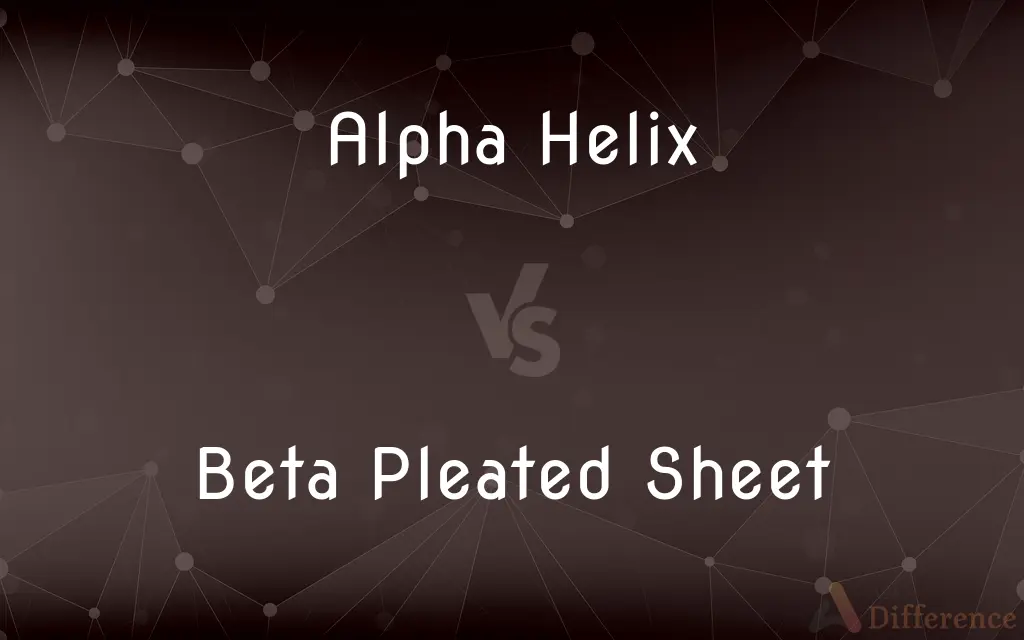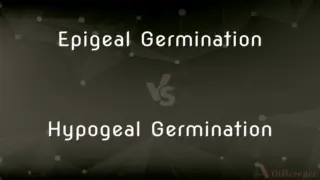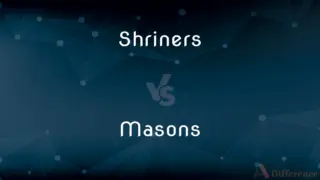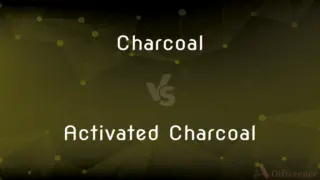Alpha Helix vs. Beta Pleated Sheet — What's the Difference?
By Tayyaba Rehman — Published on December 25, 2023
Alpha Helix and Beta Pleated Sheet are secondary protein structures; the former is a coiled, spring-like structure while the latter consists of flat, extended strands.

Difference Between Alpha Helix and Beta Pleated Sheet
Table of Contents
ADVERTISEMENT
Key Differences
Alpha Helix and Beta Pleated Sheet are integral to the protein world, representing two dominant forms of secondary protein structures. These structures emerge due to hydrogen bonds between the backbone atoms of the polypeptide chain.
The Alpha Helix is reminiscent of a coiled spring or a corkscrew, a helical structure stabilized by hydrogen bonds. On the other hand, the Beta Pleated Sheet looks like a series of zigzags or a folded paper fan, with its strands lying adjacent to each other.
Alpha Helix structures are characterized by their compactness and are typically found in fibrous proteins, providing them elasticity. In contrast, Beta Pleated Sheet structures are more stretched out and can be parallel or antiparallel, often seen in globular proteins and silk fibers.
The formation of both the Alpha Helix and the Beta Pleated Sheet structures results from the specific spatial arrangements of amino acids and the nature of their side chains. However, while the Alpha Helix's hydrogen bonds form between every fourth amino acid, the Beta Pleated Sheet's bonds are between adjacent strands.
In essence, while both the Alpha Helix and Beta Pleated Sheet play pivotal roles in determining a protein's function and stability, they manifest distinctly in their appearance, hydrogen bonding patterns, and occurrence in proteins.
ADVERTISEMENT
Comparison Chart
Structure Appearance
Coiled, spring-like
Flat, extended strands
Hydrogen Bonding
Between every fourth amino acid
Between adjacent strands
Common Occurrence
Fibrous proteins
Globular proteins and silk fibers
Nature of Bonds
Helical
Zigzag
Typical Properties
Provides elasticity
Provides rigidity
Compare with Definitions
Alpha Helix
Alpha Helix is a helical configuration stabilized by internal hydrogen bonding.
The stability of the Alpha Helix is pivotal for certain protein functions.
Beta Pleated Sheet
Beta Pleated Sheet features hydrogen bonds between adjacent strands.
The rigidity in certain proteins is due to the Beta Pleated Sheet.
Alpha Helix
Alpha Helix is often seen in fibrous proteins.
The coiled design of the Alpha Helix provides resilience to some proteins.
Beta Pleated Sheet
Beta Pleated Sheet can be antiparallel or parallel in orientation.
The alignment in Beta Pleated Sheets determines their properties in proteins.
Alpha Helix
Alpha Helix is a coiled secondary structure of proteins.
The elasticity in hair is due to the presence of the Alpha Helix structure.
Beta Pleated Sheet
Beta Pleated Sheet provides a folded, sheet-like appearance.
The unique folding in Beta Pleated Sheet allows for protein stacking.
Alpha Helix
Alpha Helix represents one of the key secondary structures in proteins.
Understanding the Alpha Helix helps in comprehending protein folding.
Beta Pleated Sheet
Beta Pleated Sheet is a common structure in globular proteins.
Enzymes often have regions of Beta Pleated Sheet.
Alpha Helix
Alpha Helix arises from hydrogen bonds between every fourth amino acid.
Keratin, a protein in our hair and nails, prominently features the Alpha Helix.
Beta Pleated Sheet
Beta Pleated Sheet is a flat, extended secondary protein structure.
Silk fibers primarily consist of the Beta Pleated Sheet structure.
Common Curiosities
What is an Alpha Helix?
An Alpha Helix is a coiled, spring-like secondary protein structure.
How does a Beta Pleated Sheet differ from an Alpha Helix?
A Beta Pleated Sheet is flat and extended, while an Alpha Helix is coiled.
Which structure, Alpha Helix or Beta Pleated Sheet, appears in hair?
The Alpha Helix is the dominant structure in hair.
Which structure, Alpha Helix or Beta Pleated Sheet, provides elasticity?
The Alpha Helix provides elasticity.
Which structure, Alpha Helix or Beta Pleated Sheet, is common in silk?
The Beta Pleated Sheet is dominant in silk.
Are Beta Pleated Sheets always flat?
Yes, they are flat but can be oriented either parallel or antiparallel.
Can a protein have both Alpha Helix and Beta Pleated Sheet structures?
Yes, many proteins feature regions of both structures.
Are both Alpha Helix and Beta Pleated Sheet formed due to hydrogen bonding?
Yes, both structures result from hydrogen bonds in the polypeptide backbone.
Where can you commonly find Beta Pleated Sheets?
Beta Pleated Sheets are common in globular proteins and silk fibers.
How does the orientation of Beta Pleated Sheets affect protein properties?
Parallel and antiparallel orientations can influence protein stability and function.
Which protein structure, Alpha Helix or Beta Pleated Sheet, is more compact?
The Alpha Helix is more compact due to its coiled nature.
What type of proteins typically feature the Alpha Helix?
Fibrous proteins often have the Alpha Helix structure.
Are the hydrogen bonds in Beta Pleated Sheet and Alpha Helix similar?
No, while the Alpha Helix has bonds every fourth amino acid, the Beta Pleated Sheet has bonds between adjacent strands.
Is the Alpha Helix present in all proteins?
No, but it's a prevalent structure in many proteins.
Between the Alpha Helix and Beta Pleated Sheet, which is more rigid?
The Beta Pleated Sheet tends to be more rigid.
Share Your Discovery

Previous Comparison
Fondant vs. Royal Icing
Next Comparison
Epigeal Germination vs. Hypogeal GerminationAuthor Spotlight
Written by
Tayyaba RehmanTayyaba Rehman is a distinguished writer, currently serving as a primary contributor to askdifference.com. As a researcher in semantics and etymology, Tayyaba's passion for the complexity of languages and their distinctions has found a perfect home on the platform. Tayyaba delves into the intricacies of language, distinguishing between commonly confused words and phrases, thereby providing clarity for readers worldwide.










































